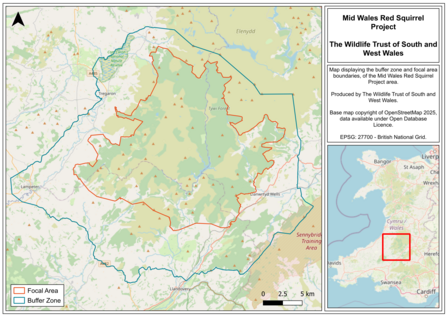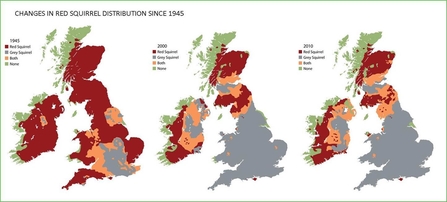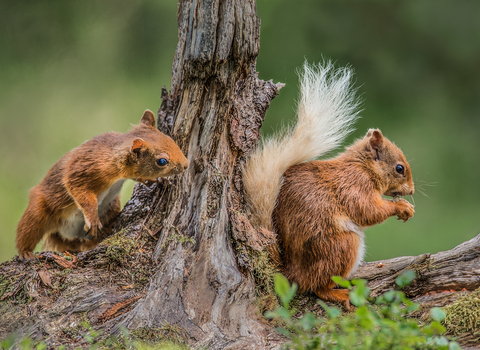Protecting our Mid Wales Red Squirrel population
The Mid Wales Red Squirrel Partnership (MWRSP) was established in 2002 to protect the unique population of Red squirrels in Mid Wales; one of only three significant Red squirrel populations in the whole of Wales, and the only one to survive without rereleases. Our work includes:
- Establishing a buffer area around the stronghold with control of Grey squirrels.
- Ongoing monitoring of the Red squirrel population.
- Advising landowners on habitat improvements for Red squirrels.
- Involving local schools and communities.
- Using forest planning to maximise the value of forests for Red squirrels.
The Grey squirrel has been identified as one of the main threats to Red squirrels' future survival; a threat which can only be mitigated with sustained local action.
The MWRSP expanded its focal site in 2023, see map below, to include Cwm Rhaeadr and Upper Tywi. This increased area represents an important step in conserving the last remaining genetically unique population of red squirrels in Wales.

Threat to Red squirrels
Habitat
A significant decline in broadleaved tree cover, increased fragmentation of woodlands and overgrazing, causing a reduction in regeneration, all contributed to the decline of red squirrels in the 19th century.
This however cannot fully explain the collapse in red squirrel numbers in the UK. Ironically, the more recently planted conifer woods do, in fact, provide some new suitable food resources for reds and may also aid their future conservation.
Competition
Red squirrels are under increasing pressure from non-native grey squirrels. The grey squirrel was introduced to the UK in the 1870s. Since the introduction of a handful of animals, grey squirrel numbers have climbed to more than 3 million.
Grey squirrels have replaced red squirrel populations throughout much of their former range; greys can colonise woodlands at a rate of 6 miles per year and reds commonly disappear within 15 years of the arrival of greys to an area.
Greys also produce more young than reds and live at higher densities (more squirrels per hectare) making them a stronger contender in the survival stakes. Although the grey squirrel has the advantage over reds in broadleaf woodlands, they are less able to dominate in coniferous woods.

Janet Wickens, 2014. Red Squirrel Survival Trust
Disease
Red squirrels are at risk from the deadly Squirrelpox virus (parapox), capable of devastating red squirrel populations. The Squirrelpox virus can be carried by grey squirrels without causing them harm, but red squirrels have no immunity. Once infected, reds will die within a matter of weeks, or even days; there is no known cure. Infected squirrels may be lethargic and shivering with scabs or lesions around the eyes and nose.
Legal Protection
The Red squirrel is included in Schedules 5 and 6 of the Wildlife & Countryside Act 1981 (WCA) which means that it is a protected species. This legislation has subsequently been amended, most recently by the Countryside & Rights of Way Act 2000 (CRoW) for England and Wales.
The inclusion of the species in Schedule 5 means that, under Section 9 of the WCA it is an offence to:
-
Intentionally kill, injure or take (capture) a Red squirrel.
-
Intentionally or recklessly damage or destroy any structure or place a Red squirrel uses for shelter or protection or disturb a Red squirrel while it is occupying such a place.
-
Possess a dead or live wild Red squirrel, or any part of a Red squirrel, unless you can show that the animal was taken legally.
-
Sell, or offer for sale, a wild Red squirrel or any part of a wild Red squirrel.
Under Section 11 of the Act, it is also illegal to:
-
Set in place a trap, snare, electrical device for killing or stunning or any poisonous, poisoned or stupefying substance; use a decoy, gas or smoke, bows or cross-bows, explosives, automatic weapons or mechanically propelled vehicles which are of such a nature and so placed as to be calculated to cause bodily injury to a Red squirrel.
Grey squirrel control is a legal activity which does not need to be licensed. The Wildlife and Countryside Act 1981 (as amended) Schedule 9 makes it illegal to release, or to allow to escape, to the wild any captive Grey squirrel; the Wild Mammals (Protection) Act 1996 makes it illegal to subject Grey squirrels to wilful acts of cruelty or abuse; and the Destructive Imported Animals Act 1932 – makes it an offence to keep a Grey squirrel in captivity, except under licence. The legislation dictates...
- It is illegal to release a trapped Grey squirrel into the wild and it is also illegal to keep a Grey squirrel in captivity.
- Any Grey squirrel caught must be humanely destroyed.
- Drowning is an inhumane method of despatch.
- When trapping for Grey squirrels, traps must be visited once every 24 hours, but, where there is a risk of catching Red squirrels or other non-target species it is a legal requirement that traps are checked twice daily.
The Mid Wales Red Squirrel Project was awarded funding through the National Lottery Heritage Fund from 2019 to 2022 to continue its vital conservation work and important research.
Images: Spotlight Red Squirrel image by Gillian Lloyd.

